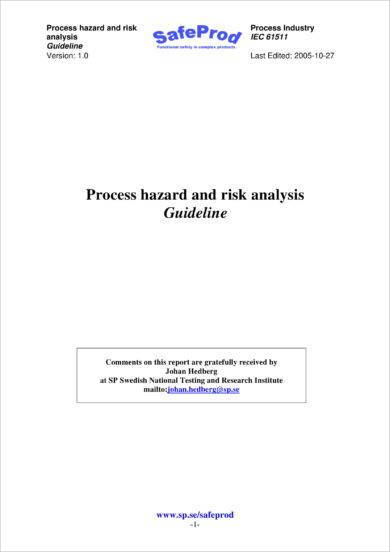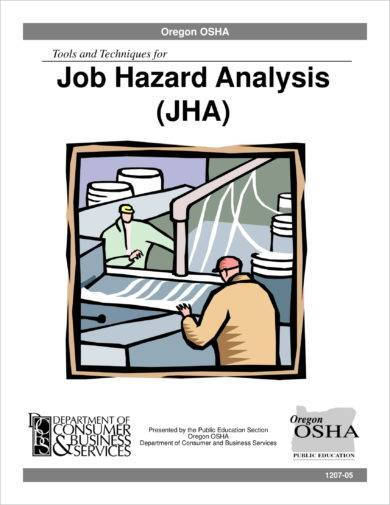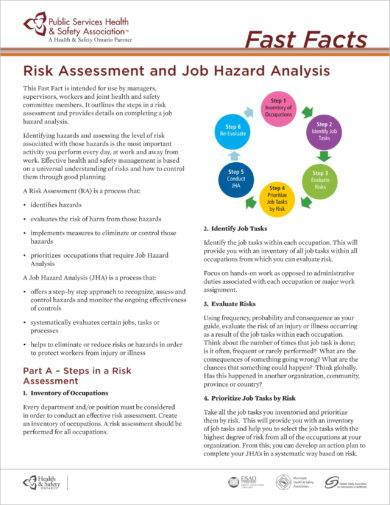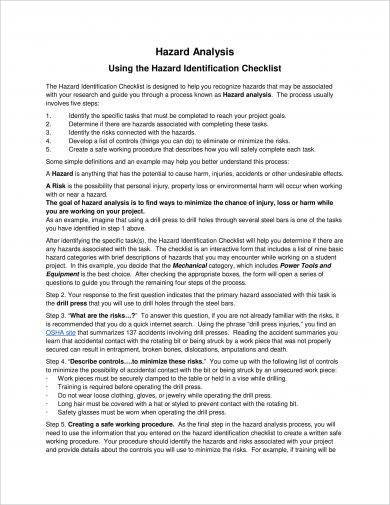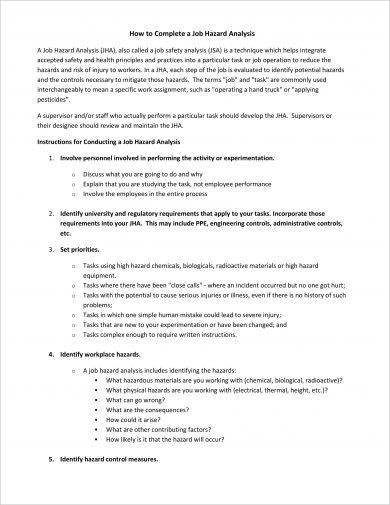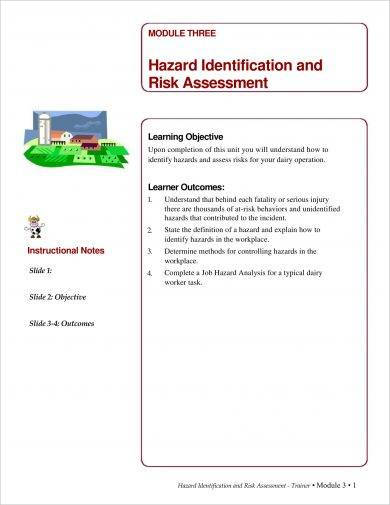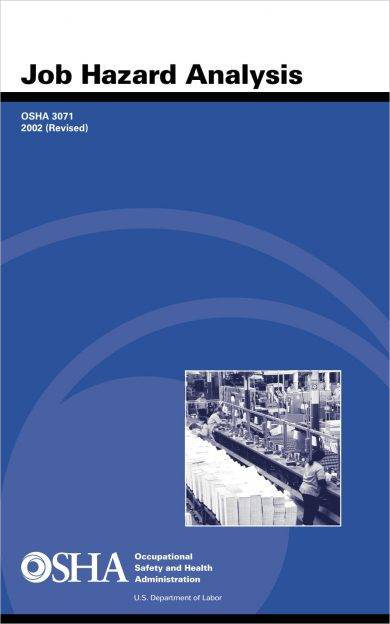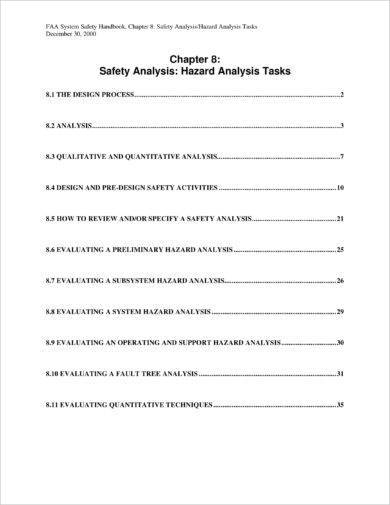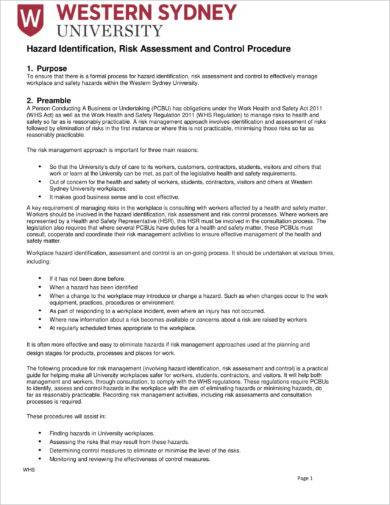14+ Hazard Analysis Examples
In a business setting, hazards can lead to mishaps, inefficiency, process failures, operational delays, and risk development. This is the reason why you have to ensure that you can analyze the hazards that are present in your business the earliest time possible so that you can eliminate them and reduce the possibility of acquiring bigger and worse damages. You may also see statement analysis examples.
Analysis examples can be very beneficial if you want to address particular hazards that can affect your operations and overall business performance. Truly, developing a hazard analysis can help you a lot when it comes to dealing with the specified matter at hand.
If you want to control risk impacts and eliminate the hazards within your business, try to develop your own hazard analysis. Do not worry if you do not have any idea on how to create this document or if you are unaware of the factors and elements that you have to put together. To help you in this undertaking, we have listed different kinds of hazard analysis examples in PDF that you can all browse through and download in this post.
Activity Hazard Analysis
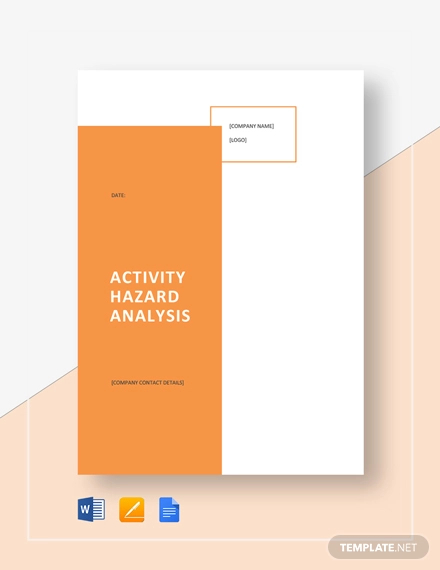
Hazard Vulnerability Analysis Design
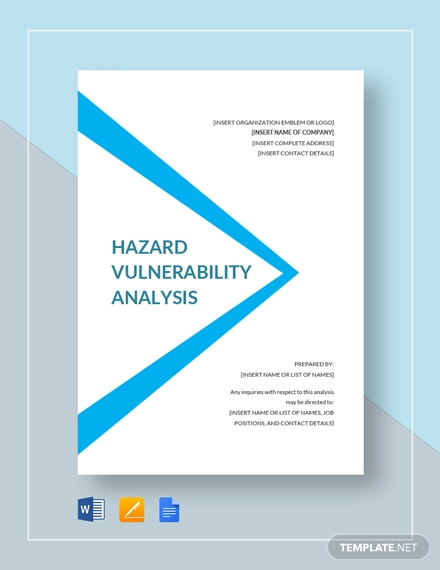
Sample Dust Hazard Analysis
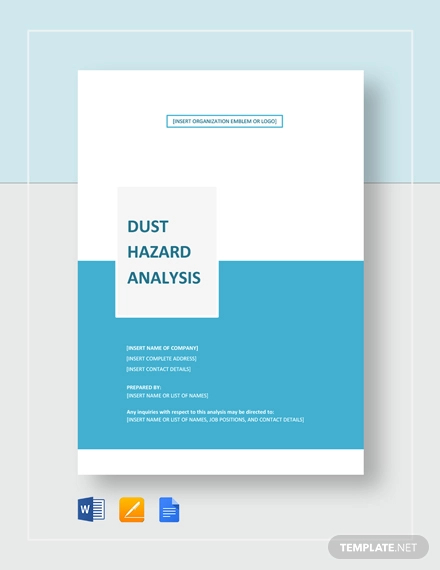
Process Hazard Analysis Example

Hazard Analysis Template

Process Hazard and Risk Analysis Example
Detailed Job Hazard Analysis Example
How to Properly Deal with Hazards for an Effective Analysis
Prior to the assessment and simple analysis of risks within your business environment or organization, you first have to analyze the hazards that serve as contributing factors for the existence of the risks that you currently need to look into. The proper identification of the types of hazards that you have to deal with can make it easier for you to know the potential or possible existence of risks once particular activities or action plans are implemented.
Here are some ways on how you can look into different kinds of hazards so that you can efficiently evaluate or assess their existence and possible impacts:
1. Know the severity of the hazards that you need to deal with. There are different severity levels that can dictate the scope or range of impacts that your business can experience if particular hazards are overlooked, unseen, or observed inappropriately. The severity of hazards begin from those that have no safety effect up to hazardous or catastrophic which can result to fatalities, losses, and capability reduction. You may also see customer analysis examples.
2. Identify the likelihood of specific hazards to occur. It is essential for you to always monitor the occurrences of hazards so that you can identify the trends that can dictate how hazards are formed or how they escalate. This will allow you to create corrective measures and counter actions that can impact the preparedness of the workforce when eliminate hazards or even facing its effects. You may also like company analysis examples.
3. Assess the nature of particular hazards. Are these hazards formed in groups or are you dealing with hazards that exists on its own? It is imperative for you to know this information so that you can have control when it comes to the cause-and-effect scenario that you have to immerse yourself in when analyzing hazards and other relevant and related details. You may also check out sales analysis examples.
Risk Assessment and Job Hazard Analysis Example
Hazard Analysis Example
Job Hazard Analysis Completion Example
How to Conduct Hazard Analysis
When creating damage report examples, hazard analyses, and other kinds of business documents, you always have to ensure that you will come up with a detailed discussion and a comprehensive presentation of necessary and relevant information. Hence, it is essential for you to always be prepared and organized no matter what kind of document it is that you will be making.
If you plan to create a hazard analysis, there is a basic procedure that you can actually follow. However, always put in mind that you should develop a hazard analysis that is suitable or fit with the hazard-related situation or instance where your business is focusing at. Listed below is the step-by-step process that you can follow if you want to conduct hazard analysis and come up with an effective report document.
1. The first thing that you need to do is to collect any information that are available with regards the hazards that will undergo analysis. You have to review and evaluate the credibility of these information so that you can ensure that you are directed in the right way or path for an effective hazard analysis. You may also see market analysis examples.
Know whether the hazards that you will look into are within a specific area or segment of work operations or if it is a general hazard that is present in the workplace. An initial conduct of inspection with the workplace areas where these hazards are available is highly recommended. You may also like industry analysis examples.
2. Having an overview of potential hazards is not enough. You have to be specific when listing down all the particular hazards that are in your work environment.
You always have to monitor changes or trend development that will allow you to identify the existing hazards that you need to eliminate, the recurring ones that you must look into and further study, and the new hazards that you must prepare for. Organize a list that can help you develop segmentation when identifying different kinds of hazards. You may also check out literary analysis examples.
3. The hazards that you have listed can be further evaluated if you can supply investigation results about the impacts and effects of these hazards to the business, your operations, and your stakeholders. Look into the incidents where particular hazards are observed and identify the number of occurrences of these kinds of instances. In this manner, you can evaluate the levels of severity that these hazards have. You might be interested in needs analysis examples.
4. Once you already have a general list of your initial observations, specific hazards, and incidents where hazards can be seen, the next thing to do is to create a single document that can present these information accordingly. You have to interlink and align these details with one another so you can ensure that you can present how they are assessed and reviewed for particular purposes.
We highly recommend the usage of templates when developing a hazard analysis document as these tools will help you format your discussion in the best way possible.
5. Aside from existing and recurring hazards, you can also add a list of hazards that only occur during emergencies and unexpected situations. You can also identify hazards that are commonly associated with non-routine circumstances or situations so there will be a wider scope of hazard identification and analysis for your business. You may also see operational analysis examples.
6. Use all of the abovementioned information when developing corrective actions, general policies, regulations, and protocols. The items specified in your hazard analysis can also be used for updating work processes and operational procedures. Ensure that you will include the specification of the hazard analysis purpose in every document that you will be making so that entities can have an understanding on what particular hazard analysis materials and documents are for.
Analysis in Workplace: Hazard Identification and Risk Assessment Example
Job Hazard Analysis Example
Safety Analysis: Hazard Analysis Tasks Example
Why Does Your Business Need a Hazard Analysis?
Are there a lot of injury reports caused by the processes within your operations? Or has there been reports of illnesses that your workforce have accumulated while they are immersed in their work processes? The safety and security of your workplace can be affected by hazards that can result to unfavorable circumstances. Hence, it is essential for you to create a hazard analysis for your business. Here are some of the objectives of developing a hazard analysis:
1. A hazard analysis is necessary for your business to have a tangible document that can present the identification of hazards. Determining the hazards in your operations and systems can help you establish proper control that can positively affect not only the management of your business but the overall performance of your organization. You may also see requirements analysis examples.
2. Hazard analysis allows you to not only list down all the hazards that you have to eliminate. This document also gives you the ability to identify the root causes of these hazards, the sequences of events that lead to the hazard’s existence, and the risks that you can face once these hazards have already surfaced in your business operations. You may also like financial analysis examples.
3. Your business can obtain improvement and development if you can remove or lessen the impacts of hazards in your processes. Knowing that your system has lesser to no hazards can make you more confident that you can achieve your corporate goals.
4. Just like a security operational plan, a hazard analysis can guide your workforce on what to do once they are faced with the effects of the hazards of your business. With this, you can make sure that there is efficiency and effectiveness whenever key personnel execute actions for dealing with specific hazards.
Analysis: Hazard Identification, Risk Assessment, and Control Procedure
Hazard Identification or Analysis for a Safe Workplace Example
Preparing a Hazard Analysis for Your Business?
Just like an incident action plan, a hazard analysis can also be used to develop call-to-actions whenever impacts of hazards and risks are essential to be addressed. This is why a lot of businesses create these documents. If you will have a hazard analysis at hand, it will be easier for you to remove negative elements and factors that can contribute to the risks that your business needs to face.
Do you want to have a hazard analysis that can work for the benefit and intentions of your business? Listed below are some of the information that can help you prepare a comprehensive hazard analysis that is suitable for the current needs of your organization with regards the particular matter of analyzing hazards and knowing how to deal with them. You may also see SWOT analysis examples.
1. Be aware of the basics of hazard analysis. More so, you need to be knowledgeable of the document’s usages in relation to the hazards that are most likely to be present in the vicinity or location of your business.
Being able to apply these items in your daily operations can enable you to know how to deal with the root causes of incidents especially those that can result to injuries, losses, illnesses, and the like. It is very important for you to know the nature of these hazards and the ways on how they become present in particular time periods. You may also like regression analysis examples.
The proper identification and anticipation of these hazards can help you veer away from the circumstances listed above.
2. Not all practices, standards, techniques, tactics, and strategies of one hazard analysis procedure are applicable with other types of hazard analysis. There are different kinds of hazard analysis and there are also a variety of reasons on why there is a need to conduct this particular type of general analysis. Hence, you have to be critical when selecting the references that you will use for the creation of your own hazard analysis.
3. Always update your hazard analysis especially when there are changes that are applied in your operations or any other areas of your business management procedures. It is important for your hazard analysis to be monitored from time to time so you can be prompt when addressing new hazards or when there are recurrences of previous hazards. You may also check out feasibility analysis examples.
With the help of the hazard analysis examples that we have listed, it will be more efficient and easier for you to develop the necessary hazard analysis document that you need. Make sure to review the format and content flow of our downloadable examples as well as the relevant discussion available in this post so you can be well-guided in the creation of your own hazard analysis. You might be interested in impact analysis examples.
We hope that we have added insights on how you can come up with a comprehensive and well-formulated hazard analysis through the items available in this post.



